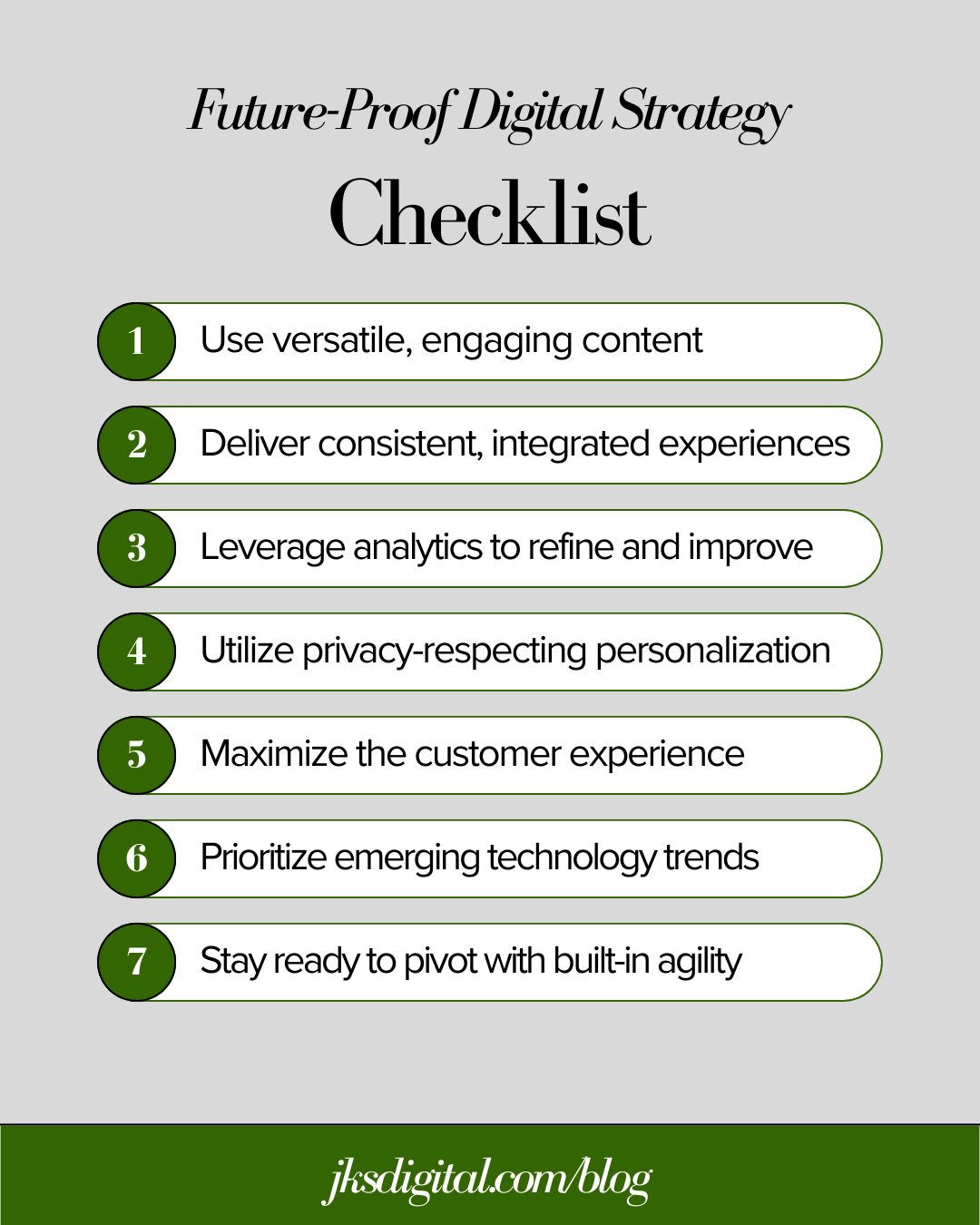The Complete Guide to Building a Future-Proof Digital Strategy
Staying ahead requires more than just a website or social media presence. Future-proofing your digital strategy means creating an adaptable, resilient approach that can pivot with evolving technology and consumer behavior. This guide breaks down the essential components for building a digital strategy that can stand the test of time, helping businesses of all sizes remain competitive and effective in an evolving landscape.
1. Establish Adaptable Content as Your Foundation
Content remains one of the most powerful tools for engaging audiences and driving growth. But in a future-proof strategy, content must be adaptable to different platforms, trends, and audience needs.
Action Steps:
Diversify Content Types: Mix blogs, videos, podcasts, and infographics to reach different audience preferences.
Repurpose Content: Extend the life of your content by repurposing blog posts into social media updates, email newsletters, or short videos.
Update Regularly: Refresh top-performing content to keep it relevant for SEO and audience interest.
2. Prioritize Omnichannel Marketing
A strong digital strategy goes beyond focusing on a single platform. With an omnichannel approach, you can reach your audience wherever they are, creating a seamless and cohesive experience across all channels. This builds brand loyalty and ensures your messaging remains consistent.
Action Steps:
Unified Messaging: Align messaging across all platforms, from social media to email and your website.
Integrated Campaigns: Synchronize campaigns across channels so that customers experience the same promotions, tone, and visuals.
Analyze Cross-Channel Data: Use insights to understand how customers move between channels and adapt your strategy accordingly.
3. Embrace Data Analytics for Informed Decision-Making
Data is at the core of a future-proof digital strategy. The right data can reveal where your strategy is succeeding and where there’s room for improvement, helping you make informed decisions that boost ROI.
Action Steps:
Implement Tracking: Use tools like Google Analytics, social media insights, and CRM systems to track and analyze audience interactions.
Define Key Metrics: Identify metrics that matter most for your business, such as conversion rates, customer retention, and customer lifetime value.
Predictive Analytics: Leverage predictive analytics to anticipate customer needs and adapt your marketing to meet future demands.
4. Invest in SEO to Stay Visible in Search Rankings
SEO is foundational to any digital strategy, ensuring that your brand remains visible when users search for products or services like yours. But search engines continually evolve, making it crucial to keep your SEO strategy future-ready.
Action Steps:
Stay Current with SEO Trends: Keep up with algorithm changes and adjust your tactics to maintain rankings.
Focus on Core Web Vitals: Optimize page load speed, mobile usability, and interactivity for better search engine performance.
Content Depth and Quality: Create comprehensive, authoritative content that meets user intent and search engine standards.
5. Implement Personalization Without Compromising Privacy
Personalization drives engagement by delivering relevant content and offers. Yet, in a world increasingly focused on data privacy, balancing personalization with respect for user data is essential.
Action Steps:
Leverage First-Party Data: Collect data directly from your audience, such as preferences and purchase history, for personalized recommendations.
Offer Opt-In Experiences: Allow customers to choose what they want to share and what type of content they want to receive.
Invest in Data Security: Use secure methods to store and manage data, respecting privacy laws and customer trust.
6. Focus on Customer Experience (CX) Across Digital Touchpoints
A future-proof digital strategy prioritizes customer experience at every stage of the journey, from discovery to post-purchase. Happy customers not only return, but they also become advocates for your brand.
Action Steps:
Map the Customer Journey: Identify pain points and opportunities for delighting your audience across each touchpoint.
Offer Real-Time Support: Utilize chatbots, live chat, and self-service options to assist customers immediately.
Gather Feedback: Regularly collect and analyze customer feedback to refine your digital experience.
7. Prepare for Emerging Technologies
The digital landscape is constantly changing, and brands need to stay aware of emerging technologies that could impact their strategy. While not every trend will be relevant, keeping an eye on developments helps you assess which technologies could enhance your efforts.
Action Steps:
Stay Informed on Trends: Follow industry updates to identify potential technologies that could benefit your strategy.
Adopt New Tools Selectively: Consider implementing tools like AI-powered customer insights or AR product previews if they align with your audience.
Test and Learn: Pilot emerging technologies on a small scale to assess their value before committing fully.
8. Build Agility into Your Strategy
A future-proof digital strategy isn’t static; it’s designed to be flexible. Digital agility means having the ability to pivot quickly in response to new developments, from market shifts to sudden consumer preferences.
Action Steps:
Create a Contingency Plan: Develop alternative strategies for potential disruptions, such as changes in algorithms or unexpected economic shifts.
Set Quarterly Reviews: Regularly revisit and refine your digital strategy to incorporate new learnings and address any challenges.
Empower Your Team: Foster a culture where employees are encouraged to innovate, test new ideas, and pivot when needed.
The Future-Proof Strategy Checklist
Future-proofing your digital strategy is about creating a resilient, adaptable approach that evolves with changing technologies and audience needs. Here’s a quick checklist to recap:
Adaptable Content: Use versatile, engaging content that resonates across channels.
Omnichannel Marketing: Deliver consistent, integrated experiences across platforms.
Data-Driven Decisions: Leverage analytics to refine strategy and improve ROI.
Strong SEO: Prioritize visibility by optimizing for evolving search engine standards.
Privacy-Respecting Personalization: Personalize experiences while safeguarding data.
Exceptional Customer Experience: Map and enhance customer journeys.
Stay Ahead with Technology: Stay aware of useful innovations and pilot new tools.
Built-In Agility: Stay ready to pivot with a flexible, regularly updated strategy.
Future-proofing your digital strategy means thinking beyond today’s challenges and trends. By investing in a well-rounded, adaptable approach, you’ll be prepared to weather changes, meet customer expectations, and thrive in a dynamic digital landscape. This is a long-term investment in your brand’s resilience—one that can pay dividends as the digital world continues to evolve.


